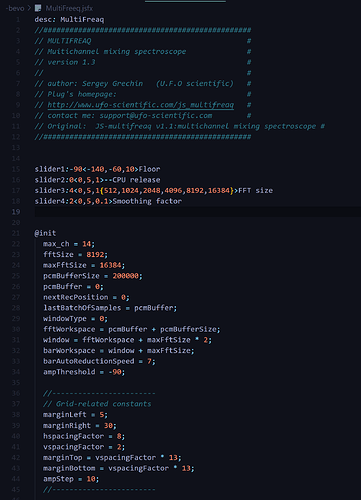ZenMod’s VU Meter uses slider1 to cycle through the ‘styles’
slider1: 1<0,9,1{Classic,Knight,Purple,Mint,Pastel,Warm,Ivory,Trooper,Ultimate,Mooncake}> -UI Style
//========================================== STYLES =================================================/
style = slider1;
style == 0 ? ( gfx_clear = 30 + 60 * 256 + 110 * 65536; );
style == 1 ? ( gfx_clear = 18 + 18 * 256 + 18 * 65536; );
style == 2 ? ( gfx_clear = 16 + 10 * 256 + 26 * 65536; );
style == 3 ? ( gfx_clear = 52 + 89 * 256 + 86 * 65536; );
style == 4 ? ( gfx_clear = 245 + 169 * 256 + 171 * 65536; );
style == 5 ? ( gfx_clear = 26 + 25 * 256 + 21 * 65536; );
style == 6 ? ( gfx_clear = 204 + 199 * 256 + 180 * 65536; );
style == 7 ? ( gfx_clear = 163 + 162 * 256 + 158 * 65536; );
style == 8 ? ( gfx_clear = 46 + 46 * 256 + 46 * 65536; );
style == 9 ? ( gfx_clear = 30 + 31 * 256 + 35 * 65536; );
w1 = $pi * 16.5 / 180;
w2 = $pi * 45 / 180;
xw = max(1,floor((gfx_w-30) / 2));
yw = floor(xw / 1.5);
r1 = floor(yw * 0.85);
chan = 0;
while (chan <= 1) (
xd = 10 + chan*(xw+10);
mode === 1 ? xd += floor(xw/2);
yd = 10;
xa = floor(xd + xw / 2);
ya = floor(yd + yw * 1.1);
//************************************* meter background styles **************************************
// background style 0: classic
style == 0 ? ( gfx_r=1; gfx_g=1; gfx_b=0.7; gfx_rect(xd,yd,xw,yw); );
// background style 1: dark knight
style == 1 ? ( gfx_r=gfx_g=0.18431 ;gfx_b = 0.2; gfx_rect(xd,yd,xw,yw); );
// background style 2: purple
style == 2 ? ( gfx_r=0.14110; gfx_g=0.09020; gfx_b=0.21961; gfx_rect(xd,yd,xw,yw); );
// background style 3: mint
style == 3 ? ( gfx_r=0.65490; gfx_g=0.94902; gfx_b=0.92157; gfx_rect(xd,yd,xw,yw); );
// background style 4: pastel
style == 4 ? ( gfx_r=0;gfx_g=1;gfx_b=.9; gfx_rect(xd,yd,xw,yw);
!gfx_ext_flags ? (gfx_r=0.65; gfx_g=0.37; gfx_b=0.6; gfx_rect(xd,yd+yw;,xw-(xw/1.35),yw*yw ) );
gfx_r=0.85490; gfx_g=0.85490; gfx_b=0.96078; gfx_rect(xd,yd,xw,yw); gfx_a=0.79; );
// background style 5: warm
style == 5 ? ( gfx_r=1; gfx_g=0.76471; gfx_b=0.32549; gfx_a=1; gfx_rect(xd,yd,xw,yw);
gfx_r=0.87451; gfx_g=0.49412; gfx_b=0.08235; gfx_a=.10; gfx_rect(xd,yd,xw,yw/yd*1.6);
gfx_r=0.87451; gfx_g=0.49412; gfx_b=0.08235; gfx_a=.13; gfx_rect(xd,yd,xw,yw/yd*1.5);
gfx_r=0.87451; gfx_g=0.49412; gfx_b=0.08235; gfx_a=.15; gfx_rect(xd,yd,xw,yw/yd*1.4);
gfx_r=1; gfx_g=0.88235; gfx_b=0.53725; gfx_a=.1/2; gfx_rect(xd,ya*.76,xw,yw/yd*1.7);
gfx_r=1; gfx_g=0.88235; gfx_b=0.53725; gfx_a=.10; gfx_circle(xa,ya*1.15,r1*0.87,1,1);
gfx_r=1; gfx_g=0.88235; gfx_b=0.53725; gfx_a=.13; gfx_circle(xa,ya*1.20,r1*0.87,1,1);
gfx_r=1; gfx_g=0.88235; gfx_b=0.53725; gfx_a=.15; gfx_circle(xa,ya*1.25,r1*0.87,1,1);
gfx_r=1; gfx_g=0.88235; gfx_b=0.53725; gfx_a=.18; gfx_circle(xa,ya*1.30,r1*0.87,1,1);
gfx_r=1; gfx_g=0.88235; gfx_b=0.53725; gfx_a=.25; gfx_circle(xa,ya*1.27,r1*0.77,1,1);
gfx_r=0.10196; gfx_g=0.09804; gfx_b=0.08235; gfx_a=1; gfx_rect(xd,ya*0.91,xw,yw*2); );
// background style 6: ivory
style == 6 ? ( gfx_r=0.86667; gfx_g=0.85490; gfx_b=0.78039; gfx_rect(xd,yd,xw,yw); );
// background style 7: trooper
style == 7 ? ( gfx_r=gfx_g=gfx_b=0.0; gfx_a=1; gfx_rect(xd,yd,xw,yw);
gfx_r=0.14902; gfx_g=0.15294; gfx_b=0.16078; gfx_a=.1; gfx_rect(xd,yd,xw,yw/yd*1.6);
gfx_r=0.14902; gfx_g=0.15294; gfx_b=0.16078; gfx_a=.2; gfx_rect(xd,yd,xw,yw/yd*1.5);
gfx_r=0.14902; gfx_g=0.15294; gfx_b=0.16078; gfx_a=.3; gfx_rect(xd,yd,xw,yw/yd*1.4);
gfx_r=0.14902; gfx_g=0.15294; gfx_b=0.16078; gfx_a=.1; gfx_rect(xd,ya*.76,xw,yw/yd*1.7);
gfx_r=0.14902; gfx_g=0.15294; gfx_b=0.16078; gfx_a=.10; gfx_circle(xa,ya*1.10,r1*0.87,1,1);
gfx_r=0.14902; gfx_g=0.15294; gfx_b=0.16078; gfx_a=.12; gfx_circle(xa,ya*1.15,r1*0.87,1,1);
gfx_r=0.14902; gfx_g=0.15294; gfx_b=0.16078; gfx_a=.14; gfx_circle(xa,ya*1.20,r1*0.87,1,1);
gfx_r=0.14902; gfx_g=0.15294; gfx_b=0.16078; gfx_a=.15; gfx_circle(xa,ya*1.29,r1*0.87,1,1);
gfx_r=0.63922; gfx_g=0.63529; gfx_b=0.61961; gfx_a=1; gfx_rect(xd,ya*0.91,xw,yw*2); );
// background style 8: ultimate
style == 8 ? ( gfx_r=0.55294; gfx_g=0.55294; gfx_b=0.55294; gfx_rect(xd,yd,xw,yw);
gfx_r=0.42745; gfx_g=0.42745; gfx_b=0.42745; gfx_a=.65;
gfx_rect(xd+1,yd,xw-1,yw-1,0); gfx_a=1; );
// background style 9: mooncake
style == 9 ? ( gfx_r=0.03922; gfx_g=0.04314; gfx_b=0.04314; gfx_rect(xd,yd,xw,yw); );
zenomod_VU Meter (ZenoMOD).jsfx (48.1 KB)

